THE CERNUSCHI MUSEUM OF ASIAN ART, PARIS
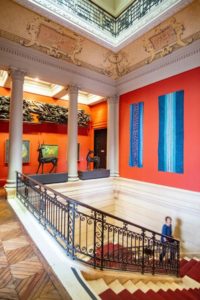
The Musée Cernuschi is relatively unknown to most visitors to Paris. Located on a quiet, leafy street that leads up to the beautiful Parc Monceau in an ultra-exclusive area of the 8th arrondissement, it’s just around the corner from the Musée Nissim de Camondo. The Cernuschi is an Asian art museum, mostly specialising in works from China, Japan, and Korea. These are objects collected by Henri Cernuschi, and displayed in a small mansion that used to be his home. He was one of the first collectors in France to amass such a vast and important collection of Asian art.
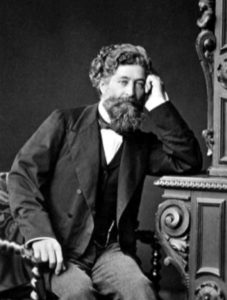
Born Enrico Cernuschi in Milan in 1821, he studied law and finance in Milan and Pavia, and obtained a licence to practice law in 1846. Some of his economist colleagues would later describe him as a man of fiery temper and brave heart. He was also an Italian patriot, one of the three “heroes” who in 1848 liberated Milan from Austrian occupation. He then left for Rome, where he was elected to the short-lived Roman Republic (1848-49). When it collapsed, he was arrested, tried, and although twice acquitted in 1850, escaped to France.
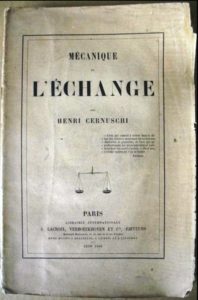
His first years proved difficult, eking out a living by giving Italian lessons and working as a copyist, while at the same time learning other languages and studying economics and banking subjects. In 1852, he joined Credit Mobilier, a highly-reputed real estate specialist bank, eventually obtaining a seat on the Board of Directors. Little by little, he built his reputation as an economist, and published Mechanique de l’échange in 1865. His consulting services and links to investors, and acquisition of shares in various businesses were highly successful, and he amassed an enormous fortune in the late Second Empire estimated to have been around 2 million gold francs.
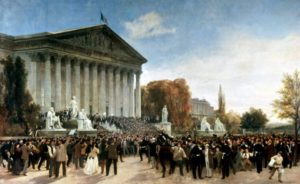
He became one of the founding directors, alongside two others, of the Banque de Paris. This bank merged with an Amsterdam-based bank to form the Banque de Paris et des Pay-Bas, later known as Paribas. However, he left the bank in 1870 when he bought a majority stake in the Republican journal Le Siècle and financially supported the committee working to defeat the motion in favour of Napoleonic-style imperial rule in France. As a result of his very public stance, the Emperor Napoleon lll forced him into exile to Switzerland, and while he was there learnt from Léon Gambetta of the collapse of the Empire. He returned immediately to Paris to be present at the proclamation of the Third Republic at the Hotel de Ville on 04 September 1870. Shortly afterwards, the minister Emmanuel Arago presented Cernuschi with his certificate of French naturalisation
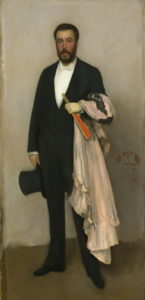
Cernuschi was profoundly shocked by the dramatic events of the Paris Commune that followed soon after, not least the death of the Editor-in-Chief of Le Siècle, and narrowly escaped execution. He fled Paris, embarking on a world tour from September 1871 to January 1873, in the company of his friend Théodore Duret, a young art critic. Duret subsequently wrote a book about their travels, Voyage en Asie, published in 1874.
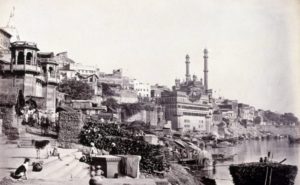
During the course of his travels in Japan, China, Java, India, and Ceylon (now Sri Lanka) Cernuschi purchased around 5,000 works of art, which would later form the core of his collection. On his return to Paris, this collection, which was exceptional for its time, particularly the bronzes, was exhibited at the Exposition Orientaliste (August 1873 – January 1874) at the Palais de l’Industrie—an old exhibition hall that was later destroyed to make way for the Grand Palais.
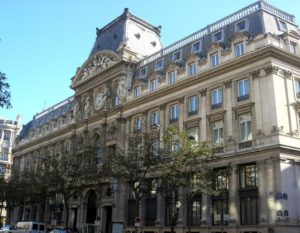
At around the same time, Henri Cernuschi purchased the last vacant plot of land on Avenue Vélasquez. He commissioned the architect William Bouwens van der Boijen, who had designed the Crédit Lyonnais headquarters, to build a small mansion where he would reside surrounded by the art works that he had brought back from his Asian travels, and where he held sumptuous parties.
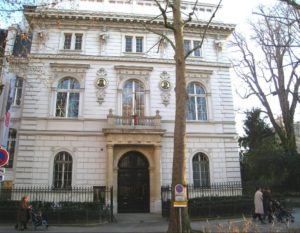
The house was built in the neoclassical style that was popular in northern Italy c.1840. The façade features mosaic medallions of Aristotle and Leonardo da Vinci, whom Cernuschi admired. On the main entrance doors are two plaques bearing the words ‘Fevrier’ and ‘Septembre’, the dates of the two revolutions of 1848 and 1870 that established the republic in France. Two figures, each representing the mythical Atlas who held up the heavens for eternity, support the wide cornice that runs around the building.
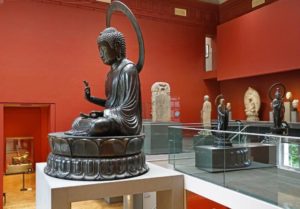
The interior is arranged around a vast, high-ceilinged central hall looking onto the Parc Monceau, and dominated by the 4.50m high bronze 18th century Buddha, known as the Amida Buddha, positioned in the middle, acquired by Cernuschi in Meguro on the outskirts of Tokyo. Plaques set into the friezes at ceiling level mark the Chinese and Japanese legs of the journey that Cernuschi and Théodore Duret undertook in Asia.
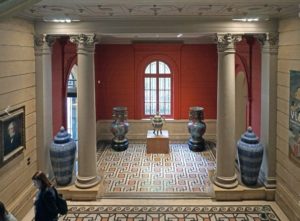
The museum is organised into different rooms and areas that relate to certain periods in Asian history. The first room on the ground floor starts with the Neolithic Period where objects on display include vases etc. that date back to around 2000BC. Other rooms on the ground floor display objects from the Shang Dynasty dating from around 1500BC onwards and include many different ceremonial items and bronzes, such as are found in ancient tombs. There are rooms highlighting pieces from the Zhou Dynasty, notably many majestic bronzes, including those from the so-called Warring States period from 481BC – 221BC.
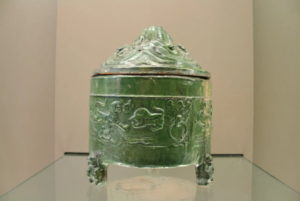
The museum has many different objects from the Qin and Han Dynasties, such as an embossed terracotta slab and a terracotta sitting goose. Throughout the museum there is a wealth of different works from later periods including ornamental objects such as camel with rider, and a person playing a musical instrument.
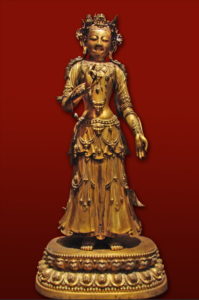
There is a room dedicated to Buddha statues of all sizes and materials from stone through to marble, showing how China turned to Buddhism and how this religion flourished throughout the different dynasties. There are galleries from the Tang, Liao and Song Dynasties displaying terracotta ornaments, a funeral headdress in gilt bronze and silver, vases and much more to keep you wondering what you will discover next.
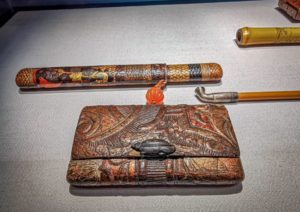
Aside from Chinese and Japanese artefacts there is a rich collection of 1,300 Vietnamese pieces including pieces from prehistory; from the Dong Song era (1000 – 100 BC); the period of Chinese domination (100 – 1000 AD); the Ly and Tan Dynasties (1009 – 1400) right up to the 20th century. In 1927, the first curator Henri d’Ardenne de Tizac, acquired Vietnamese stone, bronze and ceramic objects, and in 1933 the collection was enriched further by an anonymous gift of 50 objects from the Dong Son culture.
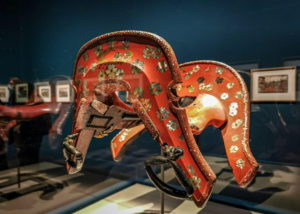
Towards the end of his life, Cernuschi retired to Menton on the Riviera, having bequeathed his Paris mansion with its collections to the City of Paris, which turned the house into the magnificent Cernuschi Museum that we can enjoy today. Henri Cernuschi died in Menton in 1896.

There is a very active Society of Friends of the Cernuschi Museum, founded in 1922. The Society’s aims are to enrich the collections of the museum as well as the Asian Arts Museum of the city of Paris through active research and to promote knowledge of Asian arts and cultures through monthly conferences and guided tours of exhibitions. Over the last few years, the Society has also brought modern and contemporary works from China, Japan, Vietnam, and Korea into the permanent collections.
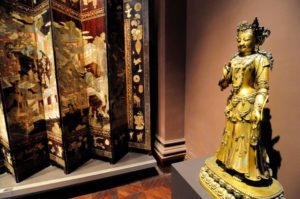
The Museum recently re-opened after a 9 month renovation. Although the original 19th century layout had been progressively amended in the 20th century, by today’s standards the condition and contents of its galleries had not adequately evolved, despite a renovation in 2005.
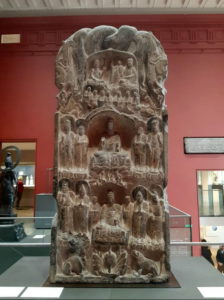
The museum was still mostly devoted to ancient China from antiquity to the Song Dynasty (960 – 1128). With this latest renovation the museum focussed on updating its permanent galleries, and opened up new spaces on the first floor allowing a much larger selection of objects—66% of the new area shows works that previously been held in reserve.
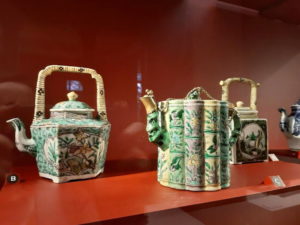
There are now 13 galleries, creating a new perspective of 5,000 years of Chinese art as well as archaeology, which is at the core of a desire to develop a broader vision of the arts and cultures of Asia. The Musée Cernuschi also has one the finest modern Chinese collections in European museums, which warranted the creation of a new picture gallery during the recent renovations.

Note that although the address for the Musée Cernuschi is 7, Ave. Velasquez, the actual entrance is at 111-113 Bvd. Malesherbes, where the beautiful wrought-iron decorative gates give access into Ave. Velasquez. Get there on Line 2 metro station Monceau or Villiers (also on Line 3), or bus nos. 30, 93 or 84
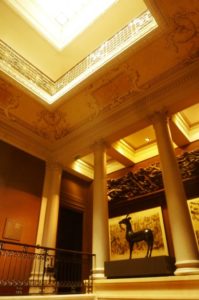
The Museum is free for the permanent collection, but a charge is made to see temporary exhibitions. The Museum is closed on Mondays.
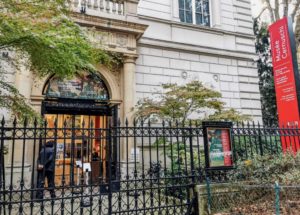
After your visit, a relaxing stroll through the Parc Monceau—one of the loveliest in Paris—is a perfect way to reflect on all extraordinary objects you’ve just seen in this beautiful museum.
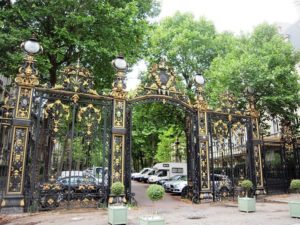


Thank you so much for the details set out here.
We will visit France and Paris specifically in October, and this will be on the visitation list.
Again, many thanks
Paul &. Paula Caine
Australia
Hi Paul and Paula,
So glad you enjoyed the latest story. We love this museum. It’s not large at all, so very manageable, and has a very specific focus, so if the finest of Asian arts and crafts are of interest, you’ll enjoy it too. Keep an eye out on the next post, as I talk about the Parc Monceau, which the Musee Cernuschi backs onto.
Once again, thank you for your feedback–always appreciated.
Kind regards,
Cheryl